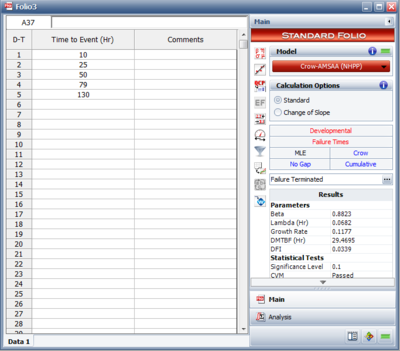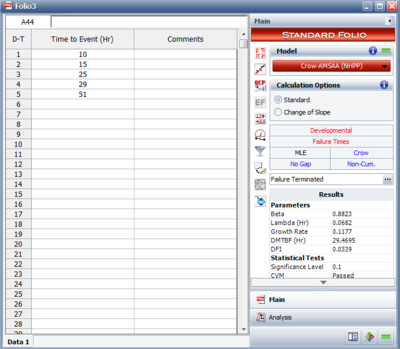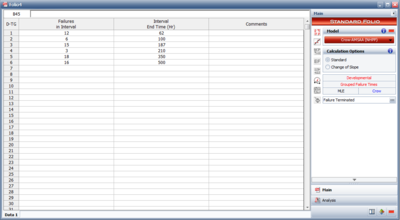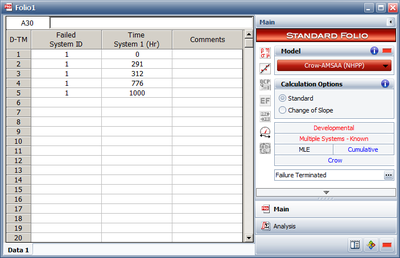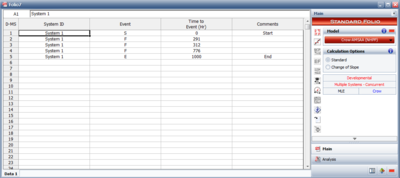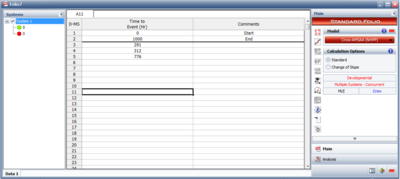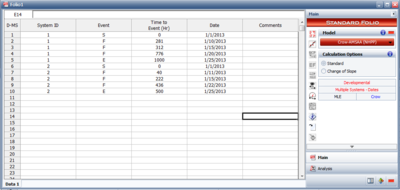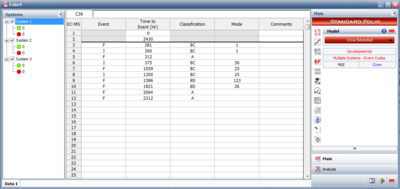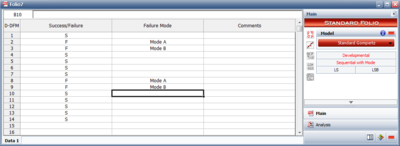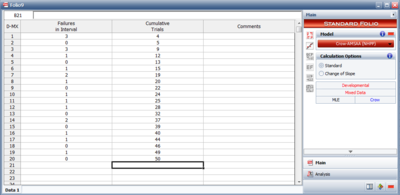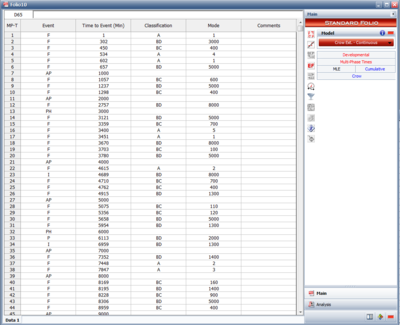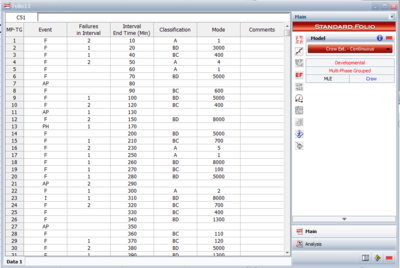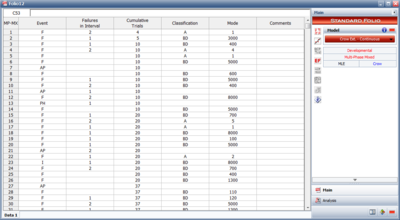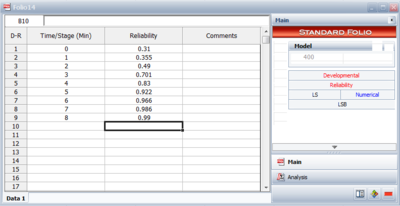Template:Developmental testing data types
Developmental Testing Data Types
Time-to-Failure Data
Time-to-failure (continuous) data is the most commonly observed type of reliability growth data. It involves recording the times-to-failure for the unit(s) under test. Time-to-failure data can be applied to a single unit or system or to multiple units or systems. There are multiple data entry schemes for this data type and each is presented next.
Failure Times Data
This data type is used for tests where the failure times are recorded. The data can be entered in a cumulative (where each row shows the total amount of test time) or non-cumulative (where each row shows the incremental test time) format, as shown next.
[math]\displaystyle{ }[/math]
Grouped Failure Times
This data type is used for tests where the exact failure times are unknown and only the number of failures within a time interval are recorded (e.g. inspection data). For a single system, multiple failures can occur before the operator stops the test. In this case, X number of failures are found after Y hours of test time. Failures X [math]\displaystyle{ _{1} }[/math] , X [math]\displaystyle{ _{2} }[/math] , X [math]\displaystyle{ _{3} }[/math] , etc. could have occurred at any time period up to the termination time, thus exact times for each failure are not available. This is commonly called interval or grouped data.
When multiple units are tested, the units are inspected at predetermined time intervals and the number of failed units is recorded. When entering the time at which the failures occurred for grouped data, the time is equal to the total accumulated test time for all of the units being tested. The number of failed units is simply equal to the number of failures that occurred during the current interval. Figure grpcum1 shows an example of data entry for grouped data.
Multiple Systems (Known Operating Times)
This data type is used for tests where a number of systems are tested. If a failure occurs in any system, a corrective action is taken on the failed unit and any design changes are incorporated into all test systems. Once the corrective actions have been implemented, the test is resumed. The time-to-failure for the failed system, along with the current operating times of all other systems, are recorded. The data can be cumulative or non-cumulative. Consider the following table where the Failed Unit ID column indicates which unit failed. For example, if you enter 2 into the Failed Unit ID column, this indicates that the unit in the Time Unit 2 column is the one that failed. For the units that did not fail, you must enter the operating time at the time of the other unit's failure.
[math]\displaystyle{ }[/math]
In this table, two units are undergoing testing and the units do not accumulate age at the same rate. At 10 hours into the test, unit 1 fails and corrective action is taken on both units 1 and 2. By this time, both units have accumulated 10 hours of operation. At 17 hours, unit 2 fails and corrective action is again implemented on both units; however, unit 1 has accumulated 5 hours and unit 2 has accumulated 7 hours since the last event, and so forth.
Multiple Systems (Concurrent Operating Times)
This data type is used for tests where a number of systems are tested and the start, end of failure times are recorded. This data type assumes uniform time accumulation and that the systems are tested simultaneously. As an example, consider the data of two systems shown in Figure fignormview. System 1 begins testing at time equals 0 (with a start event, S) and failures are encountered and corrected at 281, 312 and 776 (with failure events, F). Testing stops at 1000 hours (with an end event, E). System 2 begins testing at time equals 0 and failures are encountered and corrected at 40, 222 and 436. Testing stops at 500 hours. RGA has two options to view this type of data. Figure fignormview shows the normal view, while Figure figadvview shows the advanced view. Both figures represent the same data.
[math]\displaystyle{ }[/math]
[math]\displaystyle{ }[/math]
When entering data within the normal view, each system must be initiated with a start event. Figure fignormview shows an example of that format.
Multiple Systems (Concurrent Operating Times) - Using Dates
This is similar to the previous data type except that dates are utilized along with operating hours. This assumes noncontinuous usage and the software computes equivalent (average) usage rates. Figure fignormviewdates shows an example of this in RGA.
Multiple Systems with Event Codes
The Multiple Systems with Event Codes data type is used to analyze the failure data from a reliability growth test in which a number of systems are tested concurrently and the implemented fixes are tracked during the test phase. With this data type, all of the systems under test are assumed to have the same system hours at any given time. Figure Figdvancedultipleventodes shows an example of this type of data.
Models for Time-to-Failure (Continuous) Data
The following models can be used to analyze time-to-failure (continuous) data sets. Models and examples using the different data types are discussed in later chapters.
- 1) Duane (Chapter 4)
- 2) Crow-AMSAA (NHPP) (Chapter 5)
- 3) Crow Extended (Chapter 9)
- 4) Crow Extended - Continuous Evaluation (Chapter 10)
Discrete Data
Discrete data is also referred to as success/failure or attribute data. It involves recording data from a test for a unit when there are only two possible outcomes: success or failure. An example of this is a missile that gets fired once and it either succeeds or fails. The data types available for analyzing discrete data with the RGA software are:
• Sequential
• Sequential with Mode
• Grouped per Configuration
• Mixed Data
Sequential Data
For Sequential data, an item is tested with only two possible outcomes: success or failure. This could be a one-shot item such as a missile or an entire system that either succeeds or fails. The item is then inspected after each trial and redesigned/repaired before the next trial. Figure Sequential shows an example of this data type, where the row number in the data sheet represents the sequence of the trials. In this data set, trial #1 succeeded, trial #2 failed, and so on.
Sequential with Mode Data
Often after failure analysis you know the reason for failure during a particular trial. If this is the case, the reason for each failure can also be used in the analysis. This data entry is identical to the Sequential data with the exception that a failure code, mode or ID is added after each failure so that the analysis can take into account different failure modes. Figure SequentialMode shows an example of this type of data.
Grouped per Configuration Data
This data type is used when multiple items, instead of a single item, are tested and the number of units that fail are recorded for each configuration. The row numbers that appear on the left side of the Data Entry Spreadsheet, shown in Figure GroupConfig, represent the unique configurations. For example, row 1 indicates configuration 1 in which 10 missiles were fired and 5 failed, row 2 indicates configuration 2 in which 8 missiles were fired and 3 failed, etc. The data can be cumulative or non-cumulative.
Mixed Data
The mixed data type can have input data that is either configuration in groups or individual trial by trial, or a mixed combination of individual trials and configurations of more than one trial. Figure Mixed data shows an example of this data type. For example the first row of this data sheet shows that three failures occurred in the first four trials, the second row shows that there was no failure in the next trial while the third row shows that three failures occured in the next four trials
Models for Discrete Data
The following models can be used to analyze discrete data. Models and examples using the different data types are discussed in later chapters.
1) Duane (Chapter 4)
2) Crow-AMSAA (NHPP) (Chapter 5)
3) Crow Extended (Chapter 9)
4) Lloyd-Lipow (Chapter 6)
5) Gompertz and Modified Gompertz (Chapter 7)
6) Logistic (Chapter 8)
Multi-Phase Data
Reliability data can be analyzed across multiple phases. This is useful when an overall reliability growth program is planned and involves multiple test phases.
(Multi-Phase) Failure Times Data
This data type can be used for tests that span multiple phases and the exact failure times are recorded. Figure CECETF shows an example of multi-phase failure times data, where the different events signify failures (F), test phases (PH) or analysis points (AP).
(Multi-Phase) Grouped Failure Times Data
This data type can be used for tests that span multiple phases and the exact failure times are unknown. Only the number of failures within a time interval are recorded, as shown in Figure CECErouped.
(Multi-Phase) Mixed Data
This data type can be used for tests that span multiple phases and it allows for configuration in groups, individual trial by trial, or a mixed combination of individual trials and configurations of more than one trial. An example of this data type can be seen in Figure Multi-phase mixed data.
Models for Multi-Phase Data
The Crow Extended - Continuous Evaluation model is used to analyze data across multiple phases and is presented in Chapter 10.
Reliability Data
Reliability data consists of entering the reliability of the equipment at different times or stages. An example is shown in Figure Reliability. In this case, the process is monitored at pre-defined time intervals and the reliability is recorded. The reliability can be computed by a simple ratio of the number of units still functioning vs. the number of units that entered the test stage or by using Life Data Analysis and related methods (e.g. Weibull analysis).
Models for Reliability Data
The following models can be used to analyze reliability data sets. Models and examples using different data types are discussed in later chapters.
1) Lloyd-Lipow (Chapter 6)
2) Gompertz and Modified Gompertz (Chapter 7)
3) Logistic (Chapter 8)
